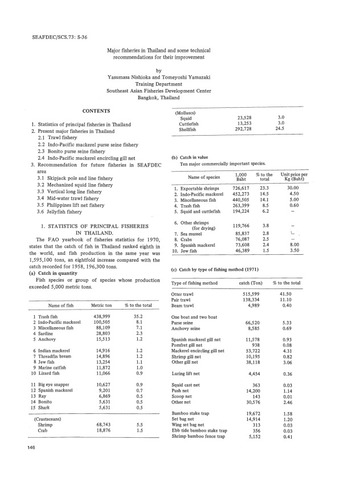| dc.contributor.author | Barut, Noel C. | |
| dc.contributor.editor | Kawamura, Hajime | |
| dc.contributor.editor | Iwata, Tsuyoshi | |
| dc.contributor.editor | Theparoonrat, Yuttana | |
| dc.contributor.editor | Manajit, Nopporn | |
| dc.contributor.editor | Sulit, Virgilia T. | |
| dc.date.accessioned | 2018-11-17T15:00:12Z | |
| dc.date.available | 2018-11-17T15:00:12Z | |
| dc.date.issued | 2016 | |
| dc.identifier.citation | Barut, N. C. (2016). Identification and establishment of fisheries refugia: Experience in the Philippines. In H. Kawamura, T. Iwata, Y. Theparoonrat, N. Manajit, & V. T. Sulit (Eds.), Consolidating the Strategies for Fishery Resources Enhancement in Southeast Asia. Proceedings of the Symposium on Strategy for Fisheries Resources Enhancement in the Southeast Asian Region, Pattaya, Thailand, 27-30 July 2015 (pp. 64-68). Samutprakan, Thailand: Training Department, Southeast Asian Fisheries Development Center. | en |
| dc.identifier.isbn | 9786163581600 | |
| dc.identifier.uri | http://hdl.handle.net/20.500.12067/723 | |
| dc.description.abstract | The process of identifying and establishing fisheries refugia is discussed in this paper, where 'fisheries refugia' is an approach that integrates fisheries and habitat management to improve fisheries management in terms of space and time for sustainable use of fish stocks and protection of habitats. Also presented in this paper are site specific studies that showed the source and sink of fish eggs and larvae used in identifying the spawning and nursery refugia. Success of fisheries refugia depends on the actions at the local level where the level of community support depends on the involvement of local stakeholders in actions. Harnessing local knowledge is critical for good site selection and establishment of management measures. Science based management measure is most acceptable while education, information and communication is very helpful in terms of community acceptance of the fisheries refugia approaches. Other resource enhancement and management described in the paper are the closed fishing season for sardines in Zamboanga Peninsula, and closed fishing season for small pelagic fishes in the Visayan Sea and Davao Gulf. The effects of these management measures are seen in increased number of fish species as well as fish production. | en |
| dc.language.iso | en | en |
| dc.publisher | Training Department, Southeast Asian Fisheries Development Center | en |
| dc.subject | Philippines | en |
| dc.title | Identification and Establishment of Fisheries Refugia: Experience in the Philippines | en |
| dc.type | Conference paper | en |
| dc.citation.spage | 64 | |
| dc.citation.epage | 68 | |
| dc.subject.asfa | resource management | en |
| dc.subject.asfa | refuges | en |
| dc.subject.asfa | sustainable fishing | en |
| dc.subject.asfa | fishery management | en |
| dc.subject.asfa | resource conservation | en |
| dc.subject.asfa | habitat improvement | en |
| dc.subject.asfa | season regulations | en |
| dc.subject.asfa | fisheries | en |
| dc.subject.asfa | stocks | en |
| dc.citation.conferenceTitle | Consolidating the Strategies for Fishery Resources Enhancement in Southeast Asia. Proceedings of the Symposium on Strategy for Fisheries Resources Enhancement in the Southeast Asian Region, Pattaya, Thailand, 27-30 July 2015 | en |



